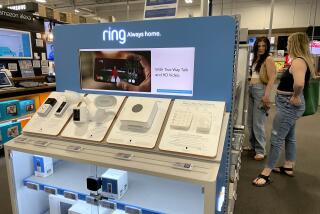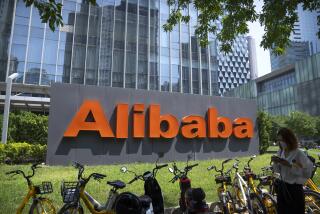Stem Cells May Help a City Heal
The headquarters of the new California Institute for Regenerative Medicine will employ just 50 people and dole out research dollars that will probably leave the Bay Area.
But to a city recovering from its brutal fall from grace when the dot-com boom went bust, the headquarters, awarded to San Francisco last week, could give it a new identity -- one fitting with the high-tech revolution it spawned, but more mature.
“The dot-com era was so 20th century, and this is so 21st century,” said Chip Conley, founder and chief executive of Joie de Vivre Hospitality, the largest San Francisco hotelier with 17 boutique-themed hotels and a day spa.
“We were at our apex. But we fell fast and hard as a city on many levels,” he said. “The stem cell headquarters ... is sort of that moment in time that says, well, the hangover is over.”
Whether the city’s new status as stem cell central will usher in an era of civic prosperity is debatable: Critics have sued to block the voter-approved stem cell financing, the science itself is young and speculative, and sky-high housing costs could deter many secondary companies from locating here.
But the prospect of revival has nevertheless sparked a conversation about how a new boom could tweak San Francisco’s sociopolitical landscape -- for better or worse.
San Francisco’s craving for a new start spawned a rare spirit of cooperation and generosity among business interests.
Leading the charge was Mayor Gavin Newsom, who put his mind to winning the institute shortly after California voters last fall approved Proposition 71, which authorized $3 billion in borrowing for embryonic stem cell research.
San Franciscans supported the measure so strongly -- by 71% compared with 59% statewide -- that Newsom decided the city should become the stem cell institute’s home. To pull it off, he corralled a new generation of civic-minded entrepreneurs and cobbled together a glitzy package of freebies totaling about $17 million.
“There’s a new wave,” said Arthur Gensler, the world-renowned architect based in San Francisco who offered pro bono design services for the stem cell offices in the Mission Bay neighborhood. “Certainly [Gap founder and chairman] Don Fisher is helping. Don’t kid yourself. But Chip [Conley] and others are saying, ‘Look, I want to be part of this community.’ ”
Planted in the heart of a swath of the city that the 37-year-old Newsom had already earmarked for biotechnology, the headquarters is likely to attract conventioneers, along with scientists and entrepreneurs in search of funding.
“Who wouldn’t want to be hanging out where they’re giving out $3 billion?” Newsom said. “I’d want to know where they’re having coffee, where they’re having pizza.”
State historian Kevin Starr -- a fourth-generation San Franciscan -- warns that secondary biotech companies may locate outside the city simply because their people cannot afford to live here.
Even if the stem cell victory triggers a more modest revival, Starr said, the nature of the industry will “accentuate the disparities between wealth and homelessness that exist today.”
“I always say that San Francisco is a combination of Carmel and Calcutta,” he added. “The new boom would have the same social tensions that the previous boom showed -- [making life] increasingly difficult for the people necessary to sustain the infrastructure of the city.”
But Newsom and others are betting the center will play to the city’s strengths. Ringed by Stanford University, UC Berkeley and UC San Francisco, and blessed with an educated workforce and more than 80 foreign consulates, the city hopes to shepherd a new era of innovation in life sciences.
Already, Newsom has discussed potential international collaboration with the consuls general of France and Britain (Prince Andrew was present too). And his office fielded calls last week from several companies that believed San Francisco already had won and wanted to explore relocation, he said.
Newsom and other city leaders believe the headquarters will accelerate a recovery already underway in Mission Bay, which once was abandoned railroad yards.
UC San Francisco has opened a new research campus nearby featuring institutes of neurological and cardiovascular disease, virology and immunology.
UC San Francisco birthed much of the biotechnology industry beginning in the early 1970s, spawning more than 70 companies, including Genentech, a cancer-drug pioneer. But with no available facilities in town, they settled in nearby cities. Genentech, which now is the world’s largest biotechnology company in terms of market value, is headquartered in South San Francisco.
Mission Bay construction efforts and the payroll-tax exemption for biotech companies are part of a broad effort to lure the industry back.
A few biotech businesses recently announced plans to move to Mission Bay, and a Pasadena developer that specializes in biotech bought 2 million square feet of development-ready land nearby.
Those developments come amid other signs that San Francisco is recovering from the trauma of the abrupt loss of 60,000 jobs in the 2000 dot-com collapse. Commercial vacancy rates have fallen, hotel occupancy and sales-tax revenue are up, and the unemployment rate recently dipped below the national level for the first time in nearly four years.
As Newsom scrambled to pull together a bid for the institute, he called on some of the city’s old guard -- among them the Gap’s Fisher and former Mayor Willie Brown. But he culled from the new too. The offers poured in.
Conley pledged $450,000 in free rooms at his hotels and challenged another major boutique hotel operator, Kimpton Hotel & Restaurant Group, to match it. They agreed. Other companies offered parking, transportation, furniture, contracting for the tenant improvements and more.
“I have been overwhelmed by people who have called me and said, ‘What can we do to help?’ ” said Dennis Conaghan, executive director of the San Francisco Center for Economic Development.
Still, San Francisco nearly failed to submit a bid. Missing from the package was the required centerpiece -- 17,000 square feet of office space free and clear for a decade. With just days left before bids were due, Newsom called a dozen top business leaders together.
“He said, ‘We’re going to lock the door. We’re not going to go home until we get this solved,’ ” venture capitalist Terry Fancher, who owns a biotech building in Mission Bay, recalled. “I think he quite seriously meant it.”
Finally, the mayor raised an unusual possibility. A mixed-use complex called the Beacon sat just across the street from the ballpark. It was mostly condominiums and bottom-floor retail.
But there were some office condos that could be outfitted for the cause. Someone in the room would have to buy them from the Santa Monica developer. That developer, Jeff Worthe, was a friend and business partner of Fancher.
“At first we were all looking around thinking, ‘Who would do that?’ ” Fancher said. “I certainly didn’t think I would.”
But Fancher did. Fisher -- a longtime San Francisco philanthropist -- has contributed substantially to defray the cost, and the mayor has pledged to raise more money for Fancher from other private sources.
What swayed Fancher, who had not previously met the mayor, was Newsom’s commitment, a plea from a top UC San Francisco official, and the belief -- shared by others there -- that stem cell research could yield cures to the most common and devastating ailments.
“I really became fairly concerned that San Francisco was just going to lose out completely and have no solution to offer,” Fancher said.
To Conley, it goes deeper.
“Stem cells, which are about healing people, could ironically be the solution to this city’s blues,” he said. “We’re going to heal by staking our claim to stem cell.”
Starr agrees that the metaphor is enticing. At social events this weekend, he heard plenty of talk of a new era of riches.
San Francisco is trying to use the stem cell victory “to tell a story about itself,” he said. But “it’s a story so far.”







